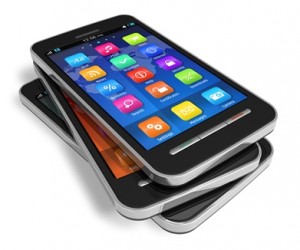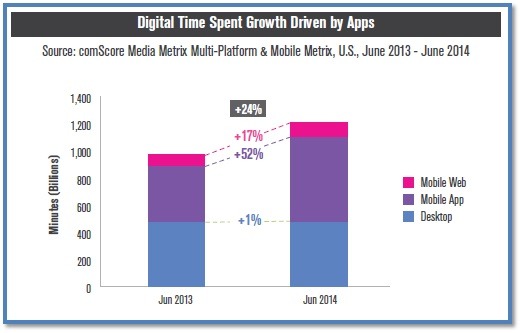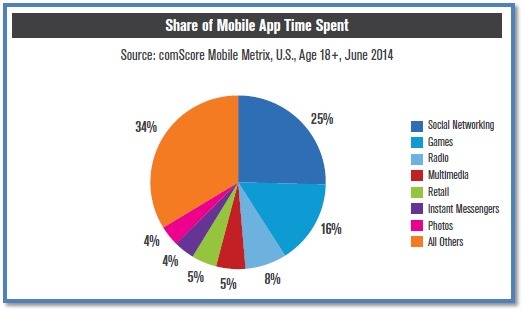 That comScore study that made the rounds last week has brought out the best (and worst) in radio as everyone tries to understand the numbers and interpret what they mean – to mobile and, of course, to broadcast radio. Like a report from the Fed about the U.S. economy, there are a lot of different “truths” in these numbers. To help provide some perspective, we asked the COO of jācapps, Bob Kernen, to give the study a look and tell us what it means. – FJ
That comScore study that made the rounds last week has brought out the best (and worst) in radio as everyone tries to understand the numbers and interpret what they mean – to mobile and, of course, to broadcast radio. Like a report from the Fed about the U.S. economy, there are a lot of different “truths” in these numbers. To help provide some perspective, we asked the COO of jācapps, Bob Kernen, to give the study a look and tell us what it means. – FJ
The industry trades this week are abuzz about whether or not we’re in an “app glut.” The catalyst for this is a comScore report that reveals that two-thirds of smartphone users didn’t download an app last month. At first, this might seem alarming to people (like me) who make apps for a living or managers for whom apps are an important part of their overall distribution strategy (like many of you).
Of course, there are other sides to these statistics. Consider that more than a third of U.S. smartphone users downloaded a minimum of one app a month. And more than half used apps every day during the month-long test. That underscores the importance of the “app majority” to everyone in radio.
And apps now occupy the majority of media time spent – 52% overall as of June 2014.
And an even bigger story is that app usage essentially comes from a few top categories. In fact, social networking, games, and radio make up just about half of all time spent (or wasted) on mobile apps. For radio – whether it’s pure-plays, aggregators like iHeartRadio, or individual station apps like we make at jacapps – this represents a major piece of the hottest digital space. And the iOS platform is even friendlier to radio apps, indexing at a whopping 149 – second only to general news apps and ahead of social networking platforms, including Facebook. With a new iPhone about to be launched, this finding becomes amplified in importance.
From the inside, our sense is that six years after the launch of the iPhone App Store, the app market is normalizing. The days of the latest fad, whether Candy Crush or Foursquare, are over, and for most of us, we’ve found the things we need, and have settled on some favorites.
So rather than the beginning of the end for apps, what I really think is occurring is the end of the beginning.
Statistics tell us that the average user has about eight apps that they use every day as well as about thirty that they use at least once a month. And the time spent on apps is currently about an hour and a quarter per day!
So the real question for media brands trying to find their way into that “Top 30” – or better yet the “Great 8” – boils down to this: What do I need to deliver to accomplish this?
The answer is at least a three-step process.
First and foremost, don’t run away from apps – run toward them. Since the invention of the AM/FM radio, the medium has never had this kind of opportunity to be a part of the hottest technology ever. Even when transistor radios were the rage, they weren’t even close to being the essential, addictive devices that smartphones have become. No other medium has this affinity with mobile that radio does. This is a storm that you want your brand to be a part of. Anyone who tells you that it’s too late for radio or that the moment has passed is doing you a disservice. Jump into the fire.
Second, drive downloads. We know from other research that the average app download costs its publisher in the neighborhood of $1.25-1.31! That could run into a lot of marketing dollars for most brands, but here’s the really good news: for radio, you have a whole lot of free megaphone usage at your disposal that will save you a fortune and net you great results. Your cume is a weapon that most brands lack.
So get on the air and start telling your listeners about your great app – not just sometimes, but all the time. Last fall, WCSX in Detroit launched a game app for deer hunting season (kind of a big deal around these parts). That app generated 55,000 downloads in just over a month. How did that happen? With over 250 on-air mentions in that period and lots of commitment, that’s how. The station got behind the app and promoted it in fun, interesting ways.
The third step is don’t stop improving on your app. Once the user has downloaded it, the heavy lifting doesn’t stop there. You have to continually remind them why it’s useful and make it engaging in as many ways as possible with updated content and great, interactive, social, viral features. That’s what WEEI/Boston does.
 Their app is a terrific resource for all things Boston sports, and they have the numbers to prove it. The app adds a steady flow of new downloads each month. When I looked at their July numbers, you couldn’t help but notice an 800% increase!
Their app is a terrific resource for all things Boston sports, and they have the numbers to prove it. The app adds a steady flow of new downloads each month. When I looked at their July numbers, you couldn’t help but notice an 800% increase!
Carlson Mozdiez, the director of Integrated Media Strategies at Entercom Boston, recalled that the last week of July was the Major League Baseball trade deadline and the Red Sox made a number of high-profile moves. The station sent its existing users push message notifications of these trades and deals. In the process, traffic on the app spiked. But clearly those users were telling their friends because new downloads jumped, too.
So while the frenzy for new apps may be waning, the mobile user is now more dependent on her device than ever and is using it for more things. As incumbent media brands, radio has a unique opportunity to cut through the noise and prove its usefulness all over again.
As the pundits debate whether radio has missed the opportunity, this comScore data suggests otherwise. In fact, it’s time to double down on mobile apps for your company and your brand.
We are a part of the “App Majority.”
- What To Do If Your Radio Station Goes Through A Midlife Crisis - April 25, 2025
- A 2020 Lesson?It Could All Be Gone In A Flash - April 24, 2025
- How AI Can Give Radio Personalities More…PERSONALITY - April 23, 2025






Leave a Reply